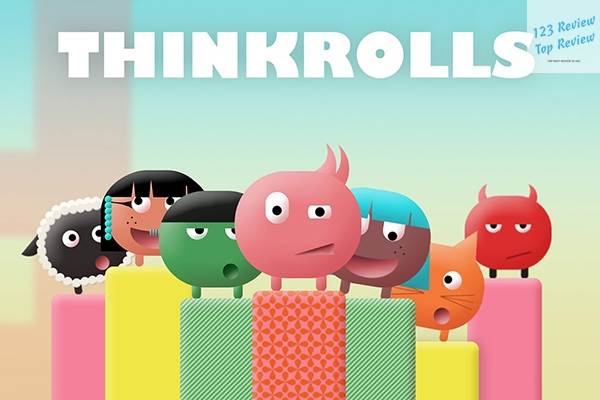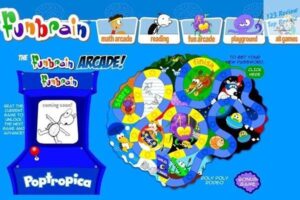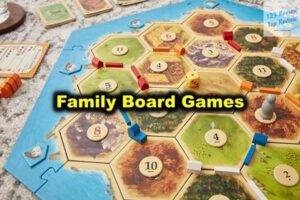In this Thinkrolls game, players guide charming, rolling characters through a series of intricate mazes and challenges that require logical thinking, problem-solving, and spatial reasoning. With progressively increasing difficulty levels tailored to various age groups, “Thinkrolls” not only entertains but also enhances critical thinking and fosters a love for learning.

In this article, 123 Review explores the features, educational benefits, and enduring appeal of the “Thinkrolls” game, highlighting why it has become a favorite among young learners and educators alike.
Overview of Thinkrolls Games
In the rapidly growing world of educational games, Thinkrolls has emerged as a standout series that blends learning and fun in a seamless, engaging experience. Developed by Avokiddo, a renowned name in educational app development, Thinkrolls is a collection of physics-based puzzle games designed specifically for children. The series is not just about entertainment; it’s about nurturing young minds, helping them develop critical thinking, problem-solving, and early STEM skills. The Thinkrolls games have been celebrated for their ability to captivate children’s attention while providing them with challenges that are both mentally stimulating and enjoyable.
Different Versions of Thinkrolls
The Thinkrolls series features several distinct versions, each offering a unique set of challenges and environments tailored to different age groups and skill levels.
- Thinkrolls 1: The original version, introduced as a groundbreaking educational tool, set the standard for what followed. It introduced the core gameplay mechanics, where players roll their Thinkrolls characters through a series of mazes filled with obstacles that must be manipulated using simple physics principles.
- Thinkrolls 2: Building on the success of the first game, Thinkrolls 2 added new characters, more complex puzzles, and additional environments. It also introduced new interactive elements, such as conveyor belts and fans, which required even more advanced problem-solving skills.
- Thinkrolls: Kings & Queens: This version took the Thinkrolls characters into a medieval setting, adding elements of fantasy and adventure. Players navigate castles, solve puzzles involving dragons, and use tools like hammers and bridges. The game also introduced a story-like progression, making it more engaging for children who enjoy narratives.
- Thinkrolls Space: In this version, the Thinkrolls characters embark on a space adventure, solving puzzles in a zero-gravity environment. The game introduces concepts like gravity, momentum, and inertia in a playful manner, making it a great choice for children interested in space and science.
Each version of Thinkrolls brings something new to the table, ensuring that the series remains fresh and exciting for players who have grown up with the games. The diversity in themes and mechanics also means that the series can appeal to a wide range of interests and learning preferences.
Key Features and Mechanics of the Thinkrolls Series
The Thinkrolls series is known for its innovative use of physics-based puzzles, which are designed to be both educational and entertaining. The core mechanics involve guiding the Thinkrolls characters through a series of increasingly complex mazes. Players must manipulate objects within these mazes to overcome obstacles and reach the end of each level.
Key features of the Thinkrolls series include:
- Physics-Based Puzzles: Each puzzle requires players to apply basic physics concepts such as gravity, force, and motion. For example, players might need to use a lever to lift an obstacle, roll a barrel to block a gap, or use a fan to blow their character across a chasm.
- Interactive Environments: The environments in Thinkrolls are not just backdrops; they are integral to the gameplay. Players must interact with various elements in the environment, such as elevators, conveyor belts, and water pools, to progress through the levels.
- Character Customization: Thinkrolls allows players to choose from a variety of characters, each with its own unique appearance. While these choices don’t affect gameplay, they add a personal touch that can make the experience more enjoyable for children.
- Progressive Difficulty: The games are designed to be accessible to a wide range of ages and skill levels. Early levels are relatively simple, but as players advance, the puzzles become more challenging, requiring more complex problem-solving and critical thinking skills.
The combination of these features makes Thinkrolls an engaging and educational experience that can hold a child’s attention for extended periods. The games are not just about solving puzzles; they are about learning how to think creatively and logically.
Educational Value of Thinkrolls for Children
One of the primary goals of the Thinkrolls series is to provide educational content in a format that is accessible and enjoyable for children. The educational value of Thinkrolls lies in its ability to teach important skills and concepts in a way that feels like play rather than learning.
- Cognitive Development: Thinkrolls games are designed to challenge and develop a child’s cognitive abilities. The puzzles require players to think critically, solve problems, and make decisions based on logic and reasoning. These cognitive skills are essential for academic success and are developed through the game’s engaging and interactive gameplay.
- STEM Learning: The series introduces children to basic STEM (Science, Technology, Engineering, and Mathematics) concepts, particularly in physics. Concepts such as gravity, force, momentum, and simple machines are all explored through the gameplay. By interacting with these concepts in a hands-on, playful environment, children can develop a deeper understanding of how the physical world works.
- Spatial Reasoning: The puzzles in Thinkrolls often require players to visualize how objects will move or interact in space. This helps develop spatial reasoning skills, which are important for success in fields like mathematics, engineering, and architecture.
- Memory and Persistence: Many of the puzzles in Thinkrolls require players to remember previous steps and apply that knowledge to future challenges. This helps improve memory and encourages persistence, as players are motivated to keep trying until they solve the puzzle.
In summary, Thinkrolls is much more than just a game; it is a valuable educational tool that can help children develop important skills that will benefit them in school and beyond.
User Experience and Gameplay
Difficulty Levels in Thinkrolls
One of the standout features of Thinkrolls is its adaptive difficulty levels, which cater to a wide range of ages and skill levels. The games are designed to start with simple, straightforward puzzles that introduce the basic mechanics and gradually increase in complexity as the player progresses.
- Early Levels: The initial levels in each Thinkrolls game are designed to be accessible even to very young children. These levels introduce basic concepts and mechanics in a way that is easy to understand and master. The challenges are simple, with clear goals and minimal obstacles, making them perfect for beginners.
- Intermediate Levels: As players advance, the puzzles become more complex, requiring more thought and planning. New mechanics are introduced, and players must start combining different actions to solve puzzles. These levels are designed to challenge children while still being achievable, encouraging them to think critically and creatively.
- Advanced Levels: The most challenging levels in Thinkrolls are designed for older children or those with more developed problem-solving skills. These levels often require multiple steps to complete and may involve more complex physics concepts. Players must use everything they have learned in the earlier levels to overcome these advanced challenges.
The progressive difficulty ensures that the game remains engaging and challenging without becoming frustrating. Children can work at their own pace, moving on to more difficult levels as they gain confidence and skill.
Customization Options for Player Profiles
Customization is an important aspect of the Thinkrolls series, allowing players to personalize their gaming experience.
- Player Profiles: Thinkrolls allows multiple player profiles, making it easy for siblings or classmates to share a device while keeping their progress separate. Each player can create a profile with a unique name and avatar, which adds a personal touch to the game.
- Character Selection: Players can choose from a variety of Thinkrolls characters, each with a distinct appearance. This customization doesn’t affect gameplay, but it allows children to express their individuality and choose a character they feel represents them.
- Progress and Achievements: Thinkrolls tracks each player’s progress through the game, allowing them to see how far they’ve come and what they have achieved. The game awards badges and other rewards for completing levels and overcoming challenges, providing additional motivation to keep playing.
These customization options enhance the user experience by making the game feel more personal and engaging. Children are more likely to stay invested in the game when they feel a sense of ownership over their profile and character.
Progress Tracking and Player Engagement
Thinkrolls excels in keeping players engaged by providing clear feedback on their progress and achievements. The game’s design encourages continuous play by offering rewards and recognition for success.
- Level Completion: Each level in Thinkrolls is carefully designed to provide a sense of accomplishment when completed. The game uses visual and auditory cues to celebrate the player’s success, which reinforces positive behavior and encourages further play.
- Achievements and Badges: As players progress through the game, they can earn various achievements and badges for reaching milestones or mastering specific skills. These rewards are displayed in the player’s profile, providing a tangible record of their accomplishments.
- Continuous Challenge: Thinkrolls is designed to be challenging but not frustrating. If a player is struggling with a particular puzzle, the game offers subtle hints to guide them toward the solution. This approach helps maintain engagement without making the game feel too easy or too difficult.
By providing continuous feedback and rewards, Thinkrolls keeps players motivated to continue playing and improving their skills. This is particularly important in educational games, where sustained engagement is key to effective learning.
Learning Outcomes and Skill Development
Problem-Solving Skills Enhanced by Thinkrolls
One of the most significant benefits of playing Thinkrolls is the enhancement of problem-solving skills. The game’s puzzles are designed to challenge children to think critically and creatively, requiring them to consider multiple factors and potential solutions.
- Critical Thinking: Thinkrolls encourages children to analyze each puzzle, identify the problem, and come up with a solution. This process requires critical thinking, as players must evaluate different strategies and decide on the best course of action.
- Creative Problem-Solving: Many puzzles in Thinkrolls have multiple possible solutions, allowing children to experiment with different approaches. This fosters creativity and encourages players to think outside the box when faced with a challenge.
- Decision-Making: Each move in Thinkrolls requires a decision, whether it’s choosing which object to move or determining the best path for the character. These decisions help develop a child’s ability to make thoughtful, informed choices.
The problem-solving skills developed through Thinkrolls are transferable to other areas of life, making the game a valuable tool for preparing children for academic and real-world challenges.
Cognitive Development Through Interactive Puzzles
In addition to problem-solving, Thinkrolls supports cognitive development in several key areas.
- Memory and Recall: Many puzzles in Thinkrolls require players to remember previous steps or strategies and apply them to new challenges. This helps strengthen memory and recall, which are essential cognitive skills.
- Logical Reasoning: The game’s puzzles often involve sequences of actions that must be completed in a specific order. This requires logical reasoning, as players must understand the cause-and-effect relationships between different elements in the puzzle.
- Attention and Focus: Thinkrolls requires sustained attention and focus, particularly in the more challenging levels. Children must pay close attention to the details of each puzzle and concentrate on finding the solution.
These cognitive skills are crucial for academic success and overall mental development. By engaging children in interactive, thought-provoking puzzles, Thinkrolls helps them build a strong foundation for future learning.
Educational Benefits and Impact
Developing Spatial Awareness and Logical Thinking
Thinkrolls is particularly effective in developing spatial awareness and logical thinking, two skills that are critical for success in STEM fields.
- Spatial Awareness: The game’s puzzles often require players to manipulate objects in space, visualize the outcome of their actions, and plan their moves accordingly. This helps develop spatial awareness, which is important for fields like mathematics, engineering, and architecture.
- Logical Thinking: Thinkrolls challenges players to think logically about how different elements in the puzzle interact with each other. This involves understanding sequences, patterns, and relationships, all of which are essential for logical thinking.
By strengthening these skills, Thinkrolls prepares children for more advanced learning in science, technology, engineering, and mathematics.
Encouraging Patience and Perseverance in Children
Thinkrolls also teaches important life skills like patience and perseverance. The game’s puzzles are designed to be challenging, but not impossible, encouraging children to keep trying until they succeed.
- Patience: Some puzzles require careful planning and multiple attempts to solve. This teaches children the value of patience and the importance of taking the time to think through a problem before acting.
- Perseverance: Thinkrolls encourages children to persist in the face of challenges. The game’s design rewards perseverance, as players are often able to find a solution after several attempts. This helps build resilience and a growth mindset.
These skills are invaluable in both academic and personal contexts, helping children develop the resilience and determination they need to succeed in life.
Conclusion
Thinkrolls is more than just a game; it is a powerful educational tool that combines entertainment with meaningful learning. Through its engaging, physics-based puzzles, Thinkrolls helps children develop critical thinking, problem-solving, and cognitive skills that will serve them well in school and beyond. The game’s progressive difficulty levels, customization options, and rewards system ensure that it remains accessible and engaging for children of all ages and skill levels.
By playing Thinkrolls, children can explore important STEM concepts in a fun and interactive way, laying the foundation for future academic success. The game’s focus on spatial awareness, logical thinking, and perseverance makes it an excellent choice for parents and educators looking for an educational game that truly delivers on its promise. Whether your child is just starting out with puzzle games or is ready for more advanced challenges, Thinkrolls offers something for everyone, making it a must-have in any educational app collection.





